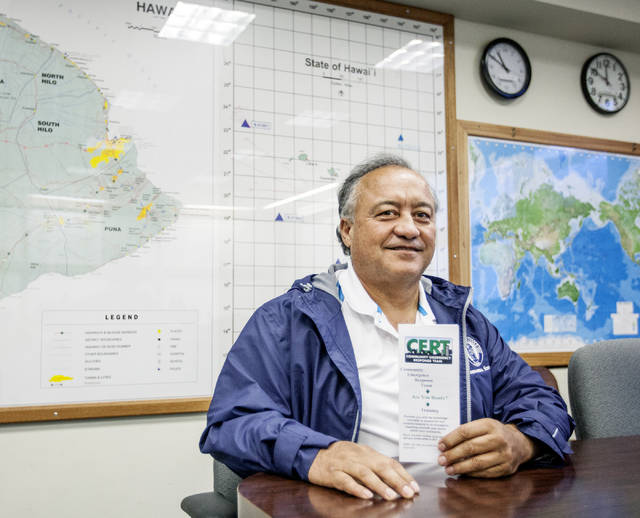HILO — Big Island residents have the opportunity to participate in a series of training courses later this month to assist the county in responding to emergencies, in case 2019 proves as turbulent as 2018.
A nationwide program by the Federal Emergency Management Agency, Community Emergency Response Teams teach volunteers how to respond to disaster situations and support professional emergency responders. The CERT training curriculum includes education about basic disaster response, emergency communications, light search and rescue and more.
Ben Hanson, administrative officer for the Hawaii County Civil Defense Agency, said there are more than 700 certified CERT members on the Big Island, divided among 24 teams. By next month, however, there could be even more.
Approximately 60 volunteers will participate in a series of four training courses starting Jan. 12 in Hilo. Completing all four courses and passing a written exam and final training exercise certifies volunteers as CERT responders.
“They are our eyes and ears in the community,” Hanson said of CERT members. “Those skills help build our community’s resiliency.”
The value of CERT was proven last year, after the island was rocked by two major natural disasters: the eruption of Kilauea in lower Puna and Hurricane Lane, which caused significant flooding throughout the windward side of the island.
CERT members assisted Civil Defense with damage assessments, escorting residents to lava-damaged properties and more, Hanson said.
Hanson said CERT members on the island clocked more than 5,000 collective volunteer man-hours during those two disasters alone.
Assistant fire chief Darwin Okinaka, who will oversee the training courses, said the federally determined curriculum will not change based on the disasters.
“The first day is more of a familiarization,” Okinaka said, explaining that the first training session — each of which lasts eight hours — will focus as much on the history and responsibilities of the CERT program as training itself.
However, Hanson said the training courses will be equal parts classwork as hands-on experience. For example, Hanson said, volunteers will learn about fire suppression in the classroom before heading outside to work with fire suppression systems themselves.
The final day of training, Feb. 9, will include a full training exercise featuring a simulated emergency that volunteers will have to respond to appropriately. The scenario will be similar to an exercise that took place last year at the Keaukaha Military Reservation, but on a smaller scale.
The Feb. 9 exercise also will allow certified CERT members to renew their certifications, which expire every two years.
Hanson said because of space limitations the Hilo courses are limited to approximately 60 attendees, the majority of which have already signed up.
“It’s a pretty great turnout, I think,” Hanson said.
Additional training courses are planned around the island this year. A series of sessions in Kona will begin Feb. 16, with more sessions in Ka‘u, Waimea and Puna taking place later throughout the year.
In addition, further training for CERT-certified volunteers will be available throughout the year, including a series of exercises that test a team’s preparedness for disasters ranging from conventional floods and earthquakes to those as outlandish as solar storms.
The first Hilo session will take place from 8:15 a.m.-4:30 p.m. Jan. 12 at the Aupuni Conference Room. Subsequent sessions will take place at the same times and location on Jan. 19 and 26 and Feb. 9.
Email Michael Brestovansky at mbrestovansky@hawaiitribune-herald.com.





